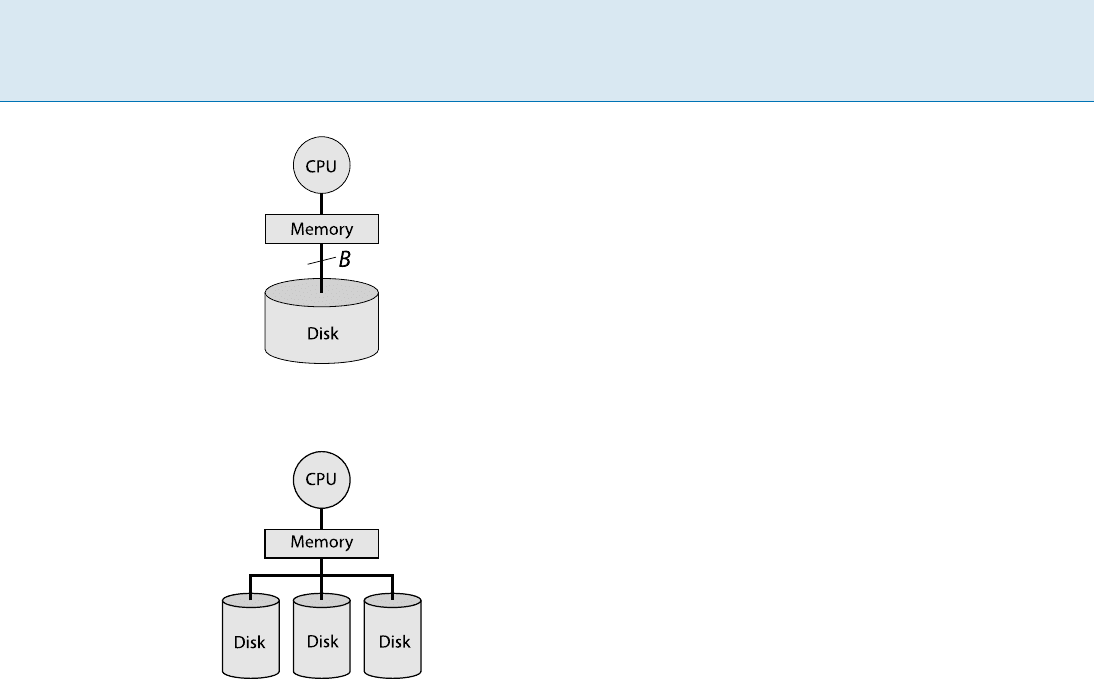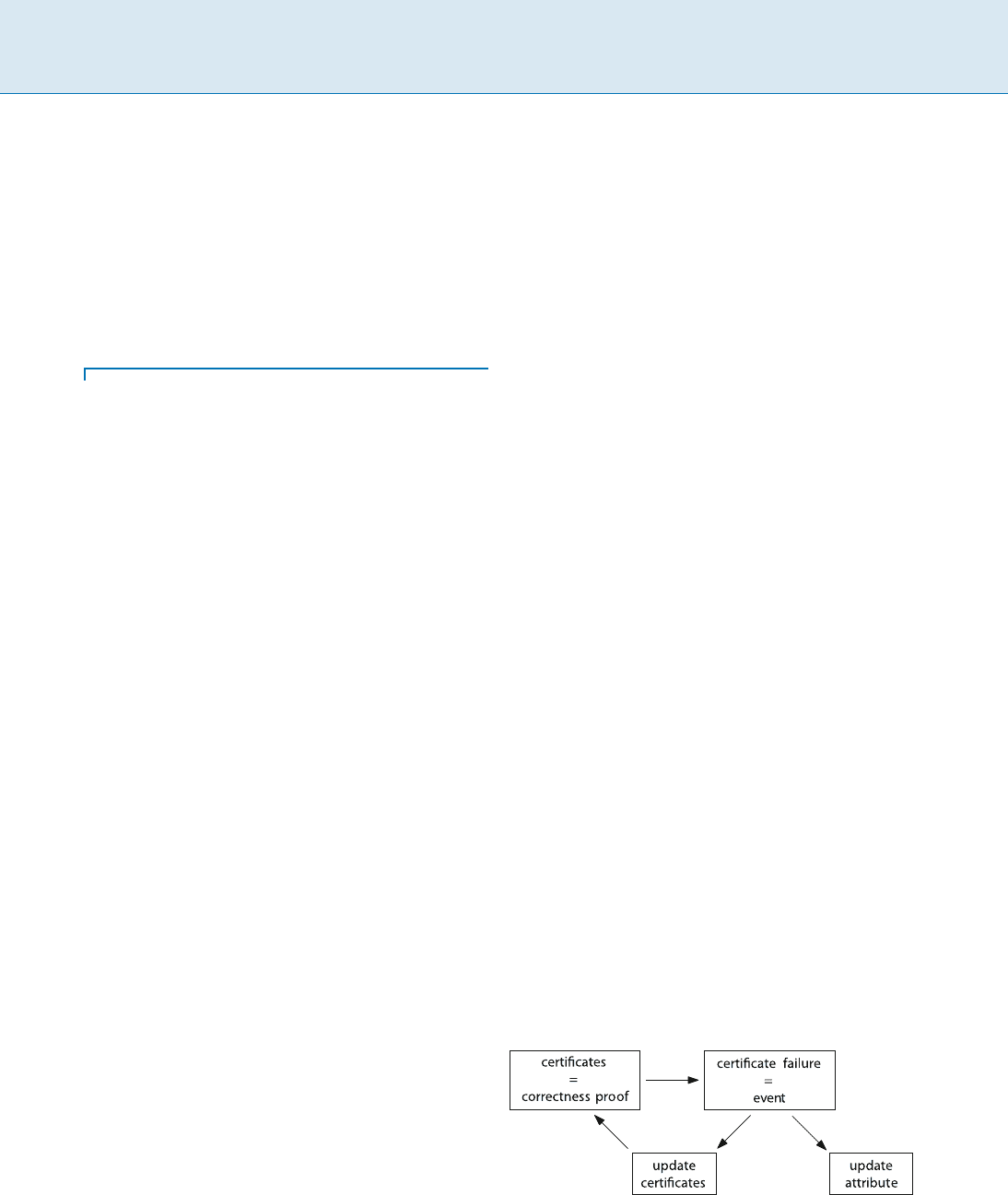Kao M.-Y. (ed.) Encyclopedia of Algorithms
Подождите немного. Документ загружается.


408 I Indexed Approximate String Matching
, certain graph properties shown for G
n;m;p
could also be
proved for G
n;m;
by showing concentration of the num-
ber of labels chosen by any vertex via Chernoff bounds.
Other than that, the fixed sizes of the sets assigned to each
vertex impose more dependencies to the model.
Cross References
Hamilton Cycles in Random Intersection Graphs
Recommended Reading
1. Alon, N., Spencer, H.: The Probabilistic Method. Wiley, Inc.
(2000)
2. Efthymiou, C., Spirakis, P.: On the existence of hamiltonian cy-
cles in random intersec- tion graphs. In: Proceedings of 32st
International colloquium on Automata, Languages and Pro-
gramming (ICALP), pp. 690–701. Springer, Berlin Heidelberg
(2005)
3. Fill, J.A., Sheinerman, E.R., Singer-Cohen, K.B.: Random inter-
section graphs when m = !(n): An equivalence theorem relat-
ing the evolution of the g(n, m, p) and g(n, p) models. Random
Struct. Algorithm. 16(2), 156–176 (2000)
4. Karo
´
nski, M., Scheinerman, E.R., Singer-Cohen, K.B.: On random
intersection graphs: The subgraph problem. Adv. Appl. Math.
8, 131–159 (1999)
5. Marczewski, E.: Sur deux propriétés des classes d‘ ensembles.
Fund. Math. 33, 303–307 (1945)
6. Motwani, R., Raghavan, P.: Randomized Algorithms. Cam-
bridge University Press (1995)
7. Nikoletseas, S., Raptopoulos, C., Spirakis, P.: The existence and
efficient construction of large independent sets in general
random intersection graphs. In: Proceedings of 31st Interna-
tional colloquium on Automata, Languages and Programming
(ICALP), pp. 1029–1040. Springer, Berlin Heidelberg (2004) Also
in the Theoretical Computer Science (TCS) Journal, accepted,
to appear in 2008
8. Raptopoulos, C., Spirakis, P.: Simple and efficient greedy algo-
rithms for hamiltonian cycles in random intersection graphs.
In: Proceedings of the 16th International Symposium on Algo-
rithms and Computation (ISAAC), pp 493–504. Springer, Berlin
Heidelberg (2005)
9. Ross, S.: Stochastic Processes. Wiley (1995)
10. Singer-Cohen, K.B.: Random Intersection Graphs. Ph. D. thesis,
John Hopkins University, Balimore (1995)
11. Stark, D.: The vertex degree distribution of random intersec-
tion graphs. Random Struct. Algorithms 24, 249–258 (2004)
Indexed Approximate
String Matching
2006; Chan, Lam, Sung, Tam, Wong
WING-KIN SUNG
Department of Computer Science, National University
of Singapore, Singapore, Singapore
Keywords and Synonyms
Indexed inexact pattern matching problem; Indexed pat-
tern searching problem based on hamming distance or edit
distance; Indexed k-mismatch problem; Indexed k-differ-
ence problem
Problem Definition
Consider a text S[1::n] over a finite alphabet ˙ . One wants
to build an index for S such that for any query pattern
P[1::m] and any integer k 0, one can report efficiently
all locations in S that match P with at most k errors. If error
is measured in terms of the Hamming distance (number of
character substitutions), the problem is called the k-mis-
match problem. If error is measured in term of the edit
distance (number of character substitutions, insertions or
deletions), the problem is called the k-difference problem.
The two problems are formally defined as follows.
Problem 1 (k-mismatch problem) Consider a text
S[1::n] over a finite alphabet ˙. For any pattern P and
threshold k, position i is an occurrence of P if the hamming
distance between P and S[i::i
0
] is less than k for some i
0
.
The k-mismatch problem asks for an index I for S such that,
for any pattern P, one can report all occurrences of P in S
efficiently.
Problem 2 (k-difference problem) Consider a text
S[1::n] over a finite alphabet ˙. For any pattern P and
threshold k, position i is an occurrence of P if the edit dis-
tance between P and S[i::i
0
] is less than k for some i
0
.The
k-difference problem asks for an index I for S such that, for
any pattern P, one can report all occurrences of P in S effi-
ciently.
The major concern of the two problems is how to achieve
efficient pattern searching without using a large amount of
space for storing the index.
Below, assume j˙j (the size of the alphabet) is con-
stant.
Key Results
Table 1 summarizes the related results in the literature. Be-
low, briefly describes the current best results.
For indexes for exact matching (k = 0), the best results
utilize data structures like the suffix tree, compressed suf-
fix array, and FM-index. Theorems 1 and 2 describe those
results.
Theorem 1 (Weiner, 1973 [17]) Given a suffix tree of size
O(n) words, one can support exact (0-mismatch) matching
in O(m + occ) time where occ is the number of occurrences.

Indexed Approximate String Matching I 409
Indexed Appr oximate String Matching, Table 1
Known results for k-difference matching. c is some positive constant and " is some positive constant smaller than 1
Space k =1
O(n log
2
n)words O(m log n log log n + occ) [1]
O(n log n)words O(m log log n + occ)
O(m + occ +logn log log n)
[2]
[8]
O(n)words O(minfn; m
2
g+ occ)
O(m log n + occ)
O(kn
log n)
O(n
)
O(m + occ +log
3
n log log n)
O(m + occ +logn log log n)
[6]
[11]
[14]
[15]
[3]
[4]
O(n
p
log n )bits O(m log log n + occ) [12]
O(n)bits O(m log
2
n + occ log n)
O((m loglog n + occ)log
n)
O(m +(occ +log
4
n log log n)log
n)
[11]
[12]
[3]
O(j˙jn)wordsinavg O(m + occ) [13]
O(j˙jn)words O(m + occ)inavg [13]
Space k = O(1)
O(n log
k
n)words O(m + occ +
1
k!
(c log n)
k
log log n) [8]
O(n log
k1
n)words O(m + k
3
3
k
occ +
1
k!
(c log n)
k
log log n) [3]
O(n)words O(minfn; j˙ j
k
m
k+2
g+ occ)
O((j˙jm)
k
log n + occ)
O(m + k
3
3
k
occ +(c log n)
k(k+1)
log log n)
O(j˙j
k
m
k1
log n log log n + k
3
3
k
occ)
[6]
[11]
[3]
[4]
O(n
p
log n )bits O((j˙jm)
k
log log n + occ) [12]
O(n)bits O((j˙jm)
k
log
2
n + occ log n)
O(((j˙jm)
k
log log n + occ)log
n)
O(m +(k
3
3
k
occ +(c log n)
k
2
+2k
log log n)log
n)
[11]
[12]
[3]
O(j˙j
k
n log
k
n)wordsinavg O(m + occ) [13]
O(j˙j
k
n log
k
n)words O(m + occ)inavg [13]
O(n log
k
n)wordsinavg O(3
k
m
k+1
+ occ) [7]
Theorem 2 (Ferragina and Manzini, 2000 [9]; Grossi and
Vitter [10]) Given a compressed suffix array or an FM-
index of size O(n) bits, one can support exact (0-mismatch)
matching in O(m + occ log
n) time, where occ is the num-
ber of occurrences and " is any positive constant smaller
than or equal to 1.
For inexact matching (k ¤ 0), there are solutions whose
indexes can help answer a k-mismatch/k-difference pat-
tern query for any k 0. Those indexes are created by
augmenting the suffix tree and its variants. Theorems 3
to 7 summarize the current best results in such direction.
Theorem 3 (Chan, Lam, Sung, Tam, and Wong,
2006 [3]) Given an index of size O(n) words, one can sup-
port k-mismatch lookup in O(m + occ +(c log n)
k(k+1)
log log n) time where c is a positive constant. For k-differ-
ence lookup, the term occ becomes k
3
3
k
occ.
Theorem 4 (Chan, Lam, Sung, Tam, and Wong,
2006 [3]) Given an index of size O(n) bits, one can sup-
port k-mismatch lookup in O(m +(occ +(c log n)
k(k+2)
log log n)log
n) time where c is a positive constant and " is
any positive constant smaller than or equal to 1. For k-dif-
ference lookup, the term occ becomes k
3
3
k
occ.
Theorem 5 (Lam, Sung, and Wong, 2005 [12]) Given an
index of size O(n
p
log n) bits, one can support k-mismatch/
k-difference lookup in O((j˙jm)
k
(k +loglogn)+occ) time.
Theorem 6 (Lam, Sung, and Wong, 2005 [12]) Given an
index of size O(n) bits, one can support k-mismatch/k-dif-
ference lookup in O(log
((j˙jm)
k
(k+loglog n)+occ)) time
where " is any positive constant smaller than or equal to 1.
Theorem 7 (Chan, Lam, Sung, Tam, and Wong,
2006 [4]) Given an index of size O(n) words, one can sup-
port k-mismatch lookup in O(j˙ j
k
m
k1
log n log log n +

410 I Indexed Approximate String Matching
occ) time. For k-difference lookup, the term occ becomes
k
3
3
k
occ.
When k is given, one can create indexes whose sizes de-
pend on k. Those solutions create the so-called k-error suf-
fix tree and its variants. Theorems 8 to 11 summarize the
current best results in this direction.
Theorem 8 (Maas and Nowak, 2005 [13]) Givenanin-
dex of size O(j˙j
k
n log
k
n) words, one can support k-mis-
match/k-difference lookup in O(m + occ) expected time.
Theorem 9 (Maas and Nowak, 2005 [13]) Consider
a uniformly and independently generated text of length n.
One can construct an index of size O(j˙ j
k
n log
k
n) words
on average, such that a k-mismatch/k-difference lookup
query can be supported in O(m + occ) worst case time.
Theorem 10 (Chan, Lam, Sung, Tam, and Wong,
2006 [3]) Given an index of size O(n log
kh+1
n) words
where h k, one can support k-mismatch lookup in O(m +
occ + c
k
2
log
maxfkh;k+hg
n log log n) time where c is a posi-
tive constant. For k-difference lookup, the term occ becomes
k
3
3
k
occ.
Theorem 11 (Chan, Lam, Sung, Tam, and Wong,
2006 [4]) Given an index of size O(n log
k1
n) words, one
can support k-mismatch lookup in O(m + occ +log
k
n
log log n) time. For k-difference lookup, the term occ be-
comes k
3
3
k
occ.
In addition, there are indexes which are efficient in prac-
tice for small k/m but give no worst case complexity guar-
antees. Those methods are based on filtration. The basic
idea is to partition the pattern into short segments and
locate those short segments in the text, allowing zero or
a small number of errors. Those short segments help to
identify candidate regions for the occurrences of the pat-
tern. Finally, by verifying those candidate regions, one can
recover all occurrences of the pattern. See [16]forasum-
mary of those results. One of the best results based on fil-
tration is stated in the following theorem.
Theorem 12 (Myers, 1994 [14]; Navarro and Baeza-
Yates, 2000 [15]) Consider an index of size O(n) words.
If k/m < 1 O(1/
p
˙), one can support a k-mismatch/
k-difference search in O(n
) expected time where " is a pos-
itive constant smaller than 1.
All the above approaches either tried to index the strings
with errors or are based on filtering. There are also so-
lutions which use radically different approaches. For in-
stance, there are solutions which transform approximate
string searching into range queries in metric space [5].
Applications
Due to the advance in both internet and biological tech-
nologies, enormous text data is accumulated. For example,
there is a 60G genomic sequence data in a gene bank. The
data size is expected to grow exponentially.
To handle the huge data size, indexing techniques are
vital to speed up the pattern matching queries. Moreover,
exact pattern matching is no longer sufficient for both in-
ternet and biological data. For example, biological data
usually contains a lot of differences due to experimental er-
ror and mutation and evolution. Therefore, approximate
pattern matching becomes more appropriate. This gives
the motivation for developing indexing techniques that al-
low pattern matching with errors.
Open Problems
The complexity for indexed approximate matching is still
not fully understood. One would like to know the answers
for a number of questions. For instance, one haves the
following two questions. (1) Given a fixed index size of
O(n) words, what is the best time complexity of a k-mis-
match/k-difference query? (2) If the k-mismatch/k-differ-
ence query time is fixed to O(m + occ), what is the best
space complexity of the index?
Cross References
Text Indexing
Two-Dimensional Pattern Indexing
Recommended Reading
1. Amir, A., Keselman, D., Landau, G.M., Lewenstein, M., Lewen-
stein, N., Rodeh, M.: Indexing and dictionary matching with
one error. In: Proceedings of Workshop on Algorithms and
Data Structures, 1999, pp. 181–192
2. Buchsbaum, A.L., Goodrich, M.T., Westbrook, J.R.: Range
searching over tree cross products. In: Proceedings of Euro-
pean Symposium on Algorithms, 2000, pp. 120–131
3. Chan, H.-L., Lam, T.-W., Sung, W.-K., Tam, S.-L., Wong, S.-S.: A lin-
ear size index for approximate pattern matching. In: Proceed-
ings of Symposium on Combinatorial Pattern Matching, 2006,
pp. 49–59
4. Chan, H.-L., Lam, T.-W., Sung, W.-K., Tam, S.-L., Wong, S.-
S.: Compressed indexes for approximate string matching. In:
Proceedings of European Symposium on Algorithms, 2006,
pp. 208–219
5. Navarro, G., Chávez, E.: A metric index for approximate string
matching. Theor. Comput. Sci. 352(1–3), 266–279 (2006)
6. Cobbs, A.: Fast approximate matching using suffix trees. In:
Proceedings of Symposium on Combinatorial Pattern Match-
ing, 1995, pp. 41–54
7. Coelho, L.P., Oliveira, A.L.: Dotted suffix trees: a structure for
approximate text indexing. In: SPIRE, 2006, pp. 329–336

Inductive Inference I 411
8. Cole, R., Gottlieb, L.A., Lewenstein, M.: Dictionary matching and
indexing with errors and don’t cares. In: Proceedings of Sym-
posium on Theory of Computing, 2004, pp. 91–100
9. Ferragina, P., Manzini, G.: Opportunistic data structures with
applications. In: Proceedings of Symposium on Foundations of
Computer Science, 2000, pp. 390–398
10. Grossi, R., Vitter, J.S.: Compressed suffix arrays and suffix trees
with applications to text indexing and string matching. In:
Proceedings of Symposium on Theory of Computing, 2000,
pp. 397–406
11. Huynh,T.N.D.,Hon,W.K.,Lam,T.W.,Sung,W.K.:Approximate
string matching using compressed suffix arrays. In: Proceed-
ings of Symposium on Combinatorial Pattern Matching, 2004,
pp. 434–444
12. Lam,T.W.,Sung,W.K.,Wong,S.S.:Improvedapproximatestring
matching using compressed suffix data structures. In: Proceed-
ings of International Symposium on Algorithms and Computa-
tion, 2005, pp. 339–348
13. Maaß, M.G., Nowak, J.: Text indexing with errors. In: Proceed-
ings of Symposium on Combinatorial Pattern Matching, 2005,
pp. 21–32
14. Myers, E.G.: A sublinear algorithm for approximate keyword
searching. Algorithmica 12, 345–374 (1994)
15. Navarro, G., Baeza-Yates R.: A hybrid indexing method for ap-
proximate string matching. J. Discret. Algorithms 1(1), 205–
209 (2000)
16. Navarro,G.,Baeza-Yates,R.A.,Sutinen,E.,Tarhio,J.:Indexing
methods for approximate string matching. IEEE Data Eng. Bull.
24(4), 19–27 (2001)
17. Weiner., P.: Linear Pattern Matching Algorithms. In: Proceed-
ings of Symposium on Switching and Automata Theory, 1973,
pp. 1–11
Inductive Inference
1983; Case, Smith
SANDRA ZILLES
Department of Computing Science, University of Alberta,
Edmonton, AB, Canada
Keywords and Synonyms
Induction; Learning from examples
Problem Definition
The theory of inductive inference is concerned with the
capabilities and limitations of machine learning. Here the
learning machine, the concepts to be learned, as well as the
hypothesis space are modeled in recursion theoretic terms,
based on the framework of identification in the limit [1,8].
Formally, considering recursive functions (mapping
natural numbers to natural numbers) as target concepts,
a learner (inductive inference machine) is supposed to
process, step by step, gradually growing segments of the
graph of a target function. In each step, the learner out-
puts a program in some fixed programming system, where
successful learning means that the sequence of programs
returned in this process eventually stabilizes on some pro-
gram actually computing the target function.
Case and Smith [2,3] have proposed several variants
of this model in order to study the influence that cer-
tain constraints or relaxations may have on the capabili-
ties of learners, thereby restricting (i) the number of mind
changes (i. e., changes of output programs) a learner is al-
lowed for in this process and (ii) the number of errors the
program eventually hypothesized may have when com-
pared to the target function.
One major result of studying the corresponding effects
is a hierarchy of inference types culminating in a model
general enough to allow for the identification of the whole
class of recursive functions by a single inductive inference
machine.
Notations
The target concepts for learning in the model discussed
below are recursive functions [13] mapping natural num-
bers to natural numbers. Such functions, as well as par-
tial recursive functions in general, are considered as com-
putable in an arbitrary, but fixed acceptable numbering
' =('
i
)
i2N
.HereN = f0; 1; 2;:::g denotes the set of all
natural numbers. is interpreted as a programming sys-
tem, where each i 2 N is called a program for the partial
recursive function '
i
.
Suppose f and g are partial recursive functions and
n 2 N.Belowf =
n
g is written if the set fx 2 N j f (x) ¤
g(x)gis of cardinality at most n.Ifthesetfx 2 N j f (x) ¤
g(x)g is finite, this is denoted by f =
g. One considers
as a special symbol for which the <-relation is extended by
n < for all n 2 N. For any recursive f and any z 2 N,let
f [z]denote(z; ( f (0);:::; f (z))) for short.
For further basic recursion theoretic notions, the
reader is referred to [13].
Learning Models
Case and Smith [3] build their theory upon the fundamen-
tal model of identification in the limit [1,8]. There a learner
can be understood as an algorithmic device, called an in-
ductive inference machine, which, given any ‘graph seg-
ment’ f [z] as its input, returns a program i 2 N.Such
a learner M identifies a recursive function f in the limit,
if there is some j 2 N such that
'
j
= f and M( f [z]) = j for all but finitely many z 2 N :

412 I Inductive Inference
A class of recursive functions is learnable in the limit, if
there is an inductive inference machine identifying each
function in the class in the limit. Identification in the limit
is called EX-identification, since a program for f is termed
an explanation for f .
For instance, the class of all primitive recursive func-
tions is EX-identifiable, whereas the class of all recursive
functions is not [8].
The central questions discussed by Case and Smith [3]
are how the limitations of EX-learners are affected by pos-
ing certain requirements on the success criterion, concern-
ing
convergence criteria,
– e. g., when restricting the number of permitted mind
changes,
– e. g., when relaxing the constraints on syntactical
convergence of the sequence of programs returned
in the learning process,
accuracy,
– e. g., when relaxing the number of permitted
anomalies in the programs returned eventually.
Problem 1 In which way do modifications of EX-identifi-
cation in terms of accuracy and convergence criteria affect
the capabilities of the corresponding learners?
Problem 2 In particular, if inaccuracies are permitted, can
EX-learners always refute inaccurate hypotheses?
Problem 3 How much relaxation of the model of EX-iden-
tification is needed to achieve learnability of the full class of
recursive functions?
Key Results
Accuracy and Convergence Constraints
In order to systematically address these problems, Case
and Smith [3] have defined inference types reflecting re-
strictions and relaxations of EX-identification as follows.
Definition 1 Suppose S is a class of recursive functions
and m; n 2 N [fg. S is EX
m
n
-identifiable, if there is an
inductive inference machine M, such that for any function
f 2 S there is some j 2 N satisfying
M( f [z]) = j for all but finitely many z 2 N,
'
j
=
m
f ,and
the cardinality of the set fz 2 N j M(f [z]) ¤ M(f [z +
1])g is at most n.
EX
m
n
denotes the set of all classes of recursive functions
which are EX
m
n
-identifiable.
Definition 2 Suppose S is a class of recursive functions
and m 2 N [fg. S is BC
m
-identifiable, if there is an
inductive inference machine M, which, for any function
f 2 S,satisfies
'
M( f [z])
=
m
f for all but finitely many z 2 N.
BC
m
denotes the set of all classes of recursive functions
which are BC
m
-identifiable. BC is short for behaviorally
correct—the difference to EX-learning is that convergence
of the sequence of programs returned by the learner is de-
fined only in terms of semantics, no longer in terms of syn-
tax.
The Impact of Accuracy and Convergence Constraints
In general, each permission of mind changes or anoma-
lies increases the capabilities of learners; however mind
changes cannot be traded in for anomalies or vice versa.
Theorem 1 Let a; b; c; d 2 N [fg.ThenEX
a
b
EX
c
d
if
and only if a candb d.
Corollary 1 For any m; n 2 N the following inclusions
hold.
1. EX
m
n
EX
m+1
n
EX
n
.
2. EX
m
n
EX
m
n+1
EX
m
.
Theorem 2 Let n 2 N.ThenEX
BC
n
BC
n+1
BC
.
These results are essential concerning Problem 1.
Refutability
In particular, refutability demands in the sense that every
incorrect hypothesis should be refutable (see [12]) are not
applicable in the theory of inductive inference, see Prob-
lem 2.
Formally, Case and Smith [3] consider refutability as
a property guaranteed by Popperian machines, the latter
being defined as follows:
Definition 3 Suppose M is an inductive inference ma-
chine M. M is Popperian if, on any input, M returns a pro-
gram of a recursive function.
Results thereon include:
Theorem 3 There is an EX-identifiable class S of recursive
functions for which there is no Popperian IIM witnessing its
EX-identifiability.
Corollary 2 There is an EX
1
-identifiable class S of recur-
sive functions for which there is no Popperian IIM witness-
ing its EX
1
-identifiability.
Additionally, in EX
1
-identification, Popper’s refutability
principle can not be applied even if it concerns only those
hypotheses returned in the limit.

I/O-model I 413
Learning All Recursive Functions
Since the results above yield a hierarchy of inference types
with strictly growing collections of learnable classes, there
is also an implicit answer to Problem 3: the class of recur-
sive functions is neither in EX
m
n
for any m; n 2 N [fg
nor in BC
m
for any m 2 N. In contrast to that, Case and
Smith [3]prove
Theorem 4 The class of all recursive functions is in BC
.
Applications
TheworkofCaseandSmith[3] has been of high impact
in learning theory.
A consequence of the discussion of anomalies has been
that refutability principles in general do not hold for iden-
tification in the limit. This result has given rise to later
studies on methods and techniques inductive inference
machines might apply in order to discover their errors [6]
and thus to further insights into the nature of inductive
inference.
Concerning the study of mind change hierarchies,
among others, their lifting to transfinite ordinal num-
bers [7]isanotableextension.
Moreover, the theory of learning as proposed by Case
and Smith [3] has been applied for the development of the
theory of identifying recursive [10] or recursively enumer-
able [9] languages.
Open Problems
Among the currently open problems in inductive infer-
ence, one key challenge is to find a reasonable notion of
the complexity of learning problems (i. e., of classes of re-
cursive functions) involving the run-time complexity of
learners as well as the number of mind changes required
to learn the functions in a class. In particular, special natu-
ral classes of functions should be analyzed in terms of such
a complexity notion.
Though of course the hierarchies EX
m
0
EX
m
1
EX
m
2
::: for any m 2 N reflect some increase of com-
plexity in that sense, a corresponding complexity notion
would not address the aspect of run-time complexity of
learners. Different complexity notions have been intro-
duced, such as the so-called intrinsic complexity [5](ne-
glecting run-time complexity) and the ‘measure under the
curve’ [4] (respecting the number of examples required,
but neglecting the number of mind changes). In partic-
ular, for learning deterministic finite automata, different
notions of run-time complexity have been discussed [11].
However, the definition of a more capacious complex-
ity notion remains an open issue.
Cross References
PAC Learning
Recommended Reading
1. Blum, L., Blum, M.: Toward a mathematical theory of inductive
inference. Inform. Control 28(2), 125–155 (1975)
2. Case, J., Smith,C.H.: Anomaly hierarchiesof mechanized induc-
tive inference. In: Proceedings of the 10th Symposium on the
Theory of Computing, pp. 314–319. ACM, New York (1978)
3. Case, J., Smith, C.H.: Comparison of Identification Criteria for
Machine Inductive Inference. Theor. Comput. Sci. 25(2), 193–
220 (1983)
4. Daley, R.P., Smith, C.H.: On the Complexity of Inductive Infer-
ence. Inform. Control 69(1–3), 12–40 (1986)
5. Freivalds, R., Kinber, E., Smith, C.H.: On the Intrinsic Complexity
of Learning. Inform. Comput. 118(2), 208–226 (1995)
6. Freivalds, R., Kinber, E., Wiehagen, R.: How inductive inference
strategies discover their errors. Inform. Comput. 123(1), 64–71
(1995)
7. Freivalds, R., Smith, C.H.: On the Role of Procrastination in Ma-
chine Learning. Inform. Comput. 107(2), 237–271 (1993)
8. Gold, E.M.: Language identification in the limit. Inform. Control
10(5), 447–474 (1967)
9. Kinber, E.B., Stephan, F.: Language Learning from Texts: Mind-
changes, Limited Memory, and Monotonicity. Inform. Comput.
123(2), 224–241 (1995)
10. Lange, S., Grieser, G., Zeugmann, T.: Inductive inference of
approximations for recursive concepts. Theor. Comput. Sci.
348(1), 15–40 (2005)
11. Pitt, L.: Inductive inference, DFAs, and computational complex-
ity. In: Analogical and Inductive Inference, 2nd International
Workshop, Reinhardsbrunn Castle, GDR. Lecture Notes in Com-
puter Science, vol. 397, pp. 18–44. Springer, Berlin (1989)
12. Popper, K.: The Logic of Scientific Discovery. Harper & Row,
New York (1959)
13. Rogers, H.: Theory of Recursive Functions and Effective Com-
putability. McGraw-Hill, New York (1967)
I/O-model
1988; Aggarwal, Vitter
NORBERT ZEH
Faculty of Computer Science, Dalhousie University,
Halifax, NS, Canada
Keywords and Synonyms
External-memory model; Disk access model (DAM)
Definition
The Input/Output model (I/O-model) [1]viewsthecom-
puter as consisting of a processor, internal memory (RAM),
and external memory (disk). See Fig. 1. The internal mem-

414 I I/O-model
I/O-model, Figure 1
The I /O-model
I/O-model, Figure 2
The parallel disk model
ory is of limited size, large enough to hold M data items.
The external memory is of conceptually unlimited size and
is divided into blocks of B consecutive data items. All com-
putationhastohappenondataininternalmemory.Data
is brought into internal memory and written back to exter-
nal memory using I/O-operations (I/Os), which are per-
formed explicitly by the algorithm. Each such operation
reads or writes one block of data from or to external mem-
ory. The complexity of an algorithm in this model is the
number of I/Os it performs.
The parallel disk model (PDM) [10] is an extension of
the I/O-model that allows the external memory to consist
of D 1 parallel disks. See Fig. 2.Inthismodel,asin-
gle I/O-operation is capable of reading or writing up to
D independent blocks, as long as each of them is stored on
a different disk.
Key Results
A few complexity bounds are of importance to virtually
every I/O-efficient algorithm or data structure. The search-
ing bound of (log
B
n) I/Os, which can be achieved using
aB-tree[4], is the cost of searching for an element in an
ordered collection of n elements, using comparisons only.
It is thus the equivalent of the (log n)searchingbound
in internal memory.
Scanning a list of n consecutive data items obviously
takes dn/Be I/Os or, in the PDM, dn/DBe I/Os. This scan-
ning bound is usually referred to asa“linearnumberof
I/Os” because it is the equivalent of the O(n)timebound
required to do the same in internal memory.
The sorting bound of sort(n)=((n/B)log
M/B
(n/B))
I/Os denotes the cost of sorting n elements using compar-
isons only. It is thus the equivalent of the (n log n)sort-
ing bound in internal memory. In the PDM, the sorting
bound becomes ((n/DB)log
M/B
(n/B)). This bound can
be achieved using a range of sorting algorithms, including
external merge sort [1,6] and distribution sort [1,5].
Arguably the most interesting bound is the permu-
tation bound,thatis,thecostofrearrangingn elements
in a given order, which is (min(sort(n); n)) [1]or,
in the PDM, (min(sort(n); n/D)) [10]. For all prac-
tical purposes, this is the same as the sorting bound.
Note the contrast to internal memory where, up to con-
stant factors, permuting has the same cost as a linear
scan. Since almost all non-trivial algorithmic problems in-
clude a permutation problem, this implies that only ex-
ceptionally simple problems can be solved in O(scan(n))
I/Os; most problems have an ˝(perm(n)), that is, es-
sentially an ˝(sort(n)) lower bound. Therefore, while
internal-memory algorithms aiming for linear time have
to carefully avoid the use of sorting as a tool, external-
memory algorithms can sort without fear of significantly
exceeding the lower bound. This makes the design of
I/O-optimal algorithms potentially easier than the de-
sign of optimal internal-memory algorithms. It is, how-
ever, counterbalanced by the fact that, unlike in inter-
nal memory, the sorting bound is not equal to n times
the searching bound, which implies that algorithms based
on querying a tree-based search structure O(n)times
usually do not translate into I/O-efficient algorithms.
Buffer trees [3] achieve an amortized search bound of
O((1/B)log
M/B
(N/B)) I/O, but can be used only if the
entire update and query sequence is known in advance
and thus provide only a limited solution to this prob-
lem.
Apart from these fundamental results, there exist
a wide range of interesting techniques, particularly for
solving geometric and graph problems. For surveys, refer
to [2,9].
Applications
Modern computers are equipped with memory hierarchies
consisting of several levels of cache memory, main mem-

I/O-model I 415
ory (RAM), and disk(s). Access latencies increase with the
distance from the processor, as do the sizes of the memory
levels. To amortize these increasing access latencies, data
are transferred between different levels of cache in blocks
of consecutive data items. As a result, the cost of a mem-
ory access depends on the level in the memory hierarchy
currently holding the data item—the difference in access
latency between L1 cache and disk is about 10
6
—and the
cost of a sequence of accesses to data items stored at the
same level depends on the number of blocks over which
these items are distributed.
Traditionally, algorithms have been designed to min-
imize the number of computation steps; the access local-
ity necessary to solve a problem using few data transfers
between memory levels has been largely ignored. Hence,
the designed algorithms work well on data sets of mod-
erate size, but do not take noticeable advantage of cache
memory and usually break down completely in out-of-
core computations. Since the difference in access laten-
cies is largest between main memory and disk, the I/O-
model focuses on minimizing this I/O-bottleneck. This
two-level view of the memory hierarchy keeps the model
simple and useful for analyzing sophisticated algorithms,
while providing a good prediction of their practical per-
formance.
Much effort has been made already to translate prov-
ably I/O-efficient algorithms into highly efficient imple-
mentations. Examples include TPIE [8] and STXXL [7],
two libraries that aim to provide highly optimized and
powerful primitives for the implementation of I/O-
efficient algorithms. In spite of these efforts, a significant
gap between the theory and practice of I/O-efficient algo-
rithms remains (see next section).
Open Problems
There are a substantial number of open problems in the
area of I/O-efficient algorithms. The most important ones
concern graph and geometric problems.
Traditional graph algorithms usually use a well-
organized graph traversal such as depth-first search or
breadth-first search to gain information about the struc-
ture of the graph and then use this information to solve the
problem at hand. In the I/O-model, no I/O-efficient depth-
first search algorithm is known and for breadth-first search
and shortest paths, progress has been made only recently
on undirected graphs. For directed graphs, even such sim-
ple problems as deciding whether there exists a directed
path between two vertices are currently open. The main
research focus in this area is therefore to either develop
I/O-efficient general traversal algorithms or to continue
the current strategy of devising graph algorithms that de-
part from traditional traversal-based approaches.
Techniques for solving geometric problems I/O-
efficiently are much better understood than is the case
for graph algorithms, at least in two dimensions. Never-
theless, there are a few important frontiers that remain.
Arguably the most important one is the development of
I/O-efficient algorithms and data structures for higher-
dimensional geometric problems. Motivated by database
applications, higher-dimensional range searching is one
of the problems to be studied in this context. Little work
has been done in the past on solving proximity prob-
lems, which pose another frontier currently explored by
researchers in the field. Motivated by the need for such
structures in a range of application areas and in partic-
ular in geographic information systems, there has been
some recent focus on the development of multifunctional
data structures, that is, structures that can answer differ-
ent types of queries efficiently. Most existing structures are
carefully tuned to efficiently support one particular type of
query.
For both, I/O-efficient graph algorithms and compu-
tational geometry, there is a substantial gap between the
obtained theoretical results and what is known to be prac-
tical, even though more experimental work has been done
on geometric algorithms than on graph algorithms. Thus,
if I/O-efficient algorithms in these areas are to have any
practical impact, increased efforts are needed to bridge this
gap by developing practically I/O-efficient algorithms that
are still provably efficient.
Cross References
For details on External Sorting and Permuting,please
refer to the corresponding entry. Details on one- and
higher-dimensional searching are provided in the entries
on B-trees and R-trees. The reader interested in algo-
rithms that focus on efficiency at all levels of the memory
hierarchy should consult the entry on the Cache-Obliv-
ious Model.
Recommended Reading
1. Aggarwal, A., Vitter, J.S.: The input/output complexity of sort-
ing and related problems. Commun. ACM 31(9), 1116–1127
(1988)
2. Arge, L.: External memory data structures. In: Abello, J., Parda-
los, P.M., Resende, M.G.C. (eds.) Handbook of Massive Data
Sets, pp. 313–357. Kluwer Academic Publishers, Dordrecht
(2002)
3. Arge, L.: The buffer tree: A technique for designing batched ex-
ternal data structures. Algorithmica 37(1), 1–24 (2003)

416 I I/O-model
4. Bayer, R., McCreight, E.: Organization of large ordered indexes.
Acta Inform. 1, 173–189 (1972)
5. Nodine, M.H., Vitter, J.S.: Deterministic distribution sort in
shared and distributed memory multiprocessors. In: Proceed-
ings of the 5th Annual ACM Symposium on Parallel Al-
gorithms and Architectures, pp. 120–129. Velen, June/July
1993
6. Nodine, M.H., Vitter, J.S.: Greed Sort: An optimal sorting algo-
rithm for multiple disks. J. ACM 42(4), 919–933 (1995)
7. STXXL: C++ Standard Library for Extra Large Data Sets. http://
stxxl.sourceforge.net. Accessed: 15 March 2008
8. TPIE A Transparent Parallel I/O-Environment. http://www.cs.
duke.edu/TPIE. Accessed: 15 March 2008
9. Vitter, J.S.: External memory algorithms and data structures:
Dealing with massive data. ACM Comput. Surv. 33(2), 209–271
(2001)
10. Vitter, J.S., Shriver, E.A.M.: Algorithms for parallel memory I:
Two-level memories. Algorithmica 12(2–3), 110–147 (1994)

Kinetic Data Structures K 417
K
Kinetic Data Structures
1999; Basch, Guibas, Hershberger
BETTINA SPECKMANN
Department of Mathematics and Computer Science,
Technical University of Eindhoven,
Eindhoven, The Netherlands
Problem Definition
Many application areas of algorithms research involve ob-
jects in motion. Virtual reality, simulation, air-traffic con-
trol, and mobile communication systems are just some
examples. Algorithms that deal with objects in motion tra-
ditionally discretize the time axis and compute or update
their structures based on the position of the objects at
every time step. If all objects move continuously then in
general their configuration does not change significantly
between time steps—the objects exhibit spatial and tem-
poral coherence.Althoughtime-discretization methods can
exploit spatial and temporal coherence they have the dis-
advantage that it is nearly impossible to choose the perfect
time step. If the distance between successive steps is too
large, then important interactions might be missed, if it is
too small, then unnecessary computations will slow down
the simulation. Even if the time step is chosen just right,
this is not always a satisfactory solution: some objects may
have moved only slightly and in such a way that the overall
data structure is not influenced.
One would like to use the temporal coherence to de-
tect precisely those points in time when there is an actual
change in the structure. The kinetic data structure (KDS)
framework, introduced by Basch et al. in their seminal
paper [2], does exactly that: by maintaining not only the
structure itself, but also some additional information, they
can determine when the structure will undergo a “real”
(combinatorial) change.
Key Results
A kinetic data structure is designed to maintain or mon-
itor a discrete attribute of a set of moving objects, for ex-
ample, the convex hull or the closest pair. The basic idea is,
that although all objects move continuously, there are only
certain discrete moments in time when the combinatorial
structure of the attribute changes (in the earlier examples,
the ordered set of convex-hull vertices or the pair that is
closest, respectively). A KDS therefore contains a set of
certificates that constitutes a proof of the property of inter-
est. Certificates are generally simple inequalities that assert
facts like “point c is on the left of the directed line through
points a and b.” These certificates are inserted in a prior-
ity queue (event queue) based on their time of expiration.
The KDS then performs an event-driven simulation of the
motion of the objects, updating the structure whenever an
event happens, that is, when a certificate fails (see Fig. 1).
It is part of the art of designing efficient kinetic data struc-
tures to find a small set of simple and easily updatable cer-
tificates that serve as a proof of the property one wishes to
maintain.
A KDS assumes that each object has a known motion
trajectory or flight plan, which may be subject to restric-
tions to make analysis tractable. Two common restrictions
would be translation along paths parametrized by poly-
nomials of fixed degree d, or translation and rotation de-
scribed by algebraic curves. Furthermore, certificates are
generally simple algebraic equations, which implies that
Kinetic Data Structures, Figure 1
The basic structure of an event based simulation with a KDS
